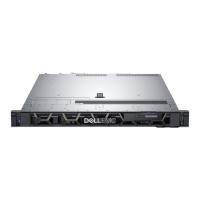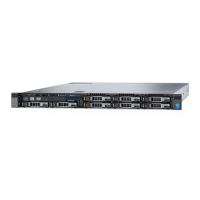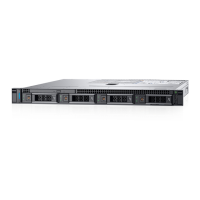3. Align the edge connector of the memory module with the alignment key of the memory module socket, and insert the memory module
in the socket.
CAUTION: To prevent damage to the memory module or the memory module socket during installation, do not bend
or flex the memory module; insert both ends of the memory module simultaneously.
NOTE: The memory module socket has an alignment key that enables you to install the memory module in the socket
in only one orientation.
CAUTION: Do not apply pressure at the center of the memory module; apply pressure at both ends of the memory
module evenly.
4. Press the memory module with your thumbs until the ejectors firmly click into place. When the memory module is properly seated in
the socket, the levers on the memory module socket align with the levers on the other sockets that have memory modules installed.
Figure 44. Installing a memory module
Next steps
1. Install the air shroud.
2. Follow the procedure listed in After working inside your system.
3. To verify if the memory module has been installed properly, press F2 and navigate to System Setup Main Menu > System BIOS >
Memory Settings. In the Memory Settings screen, the System Memory Size must reflect the updated capacity of the installed
memory.
4. If the System Memory Size is incorrect, one or more of the memory modules may not be installed properly. Ensure that the memory
modules are firmly seated in their sockets.
5. Run the system memory test in system diagnostics.
Processor and heat sink
Removing a heat sink
Prerequisites
1. Follow the safety guidelines listed in the Safety instructions.
2. Follow the procedure listed in the Before working inside your system.
3. Remove the air shroud.
NOTE:
The heat sink and processor are too hot to touch for some time after the system has been powered down.
Allow the heat sink and processor to cool down before handling them.
64 Installing and removing system components

